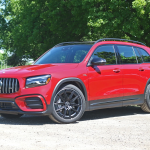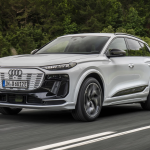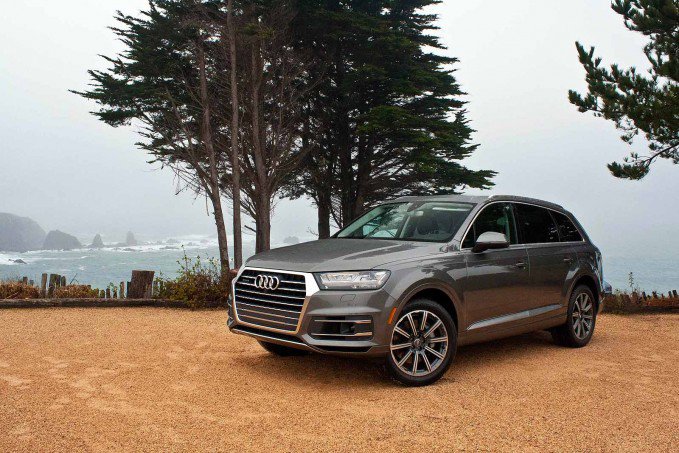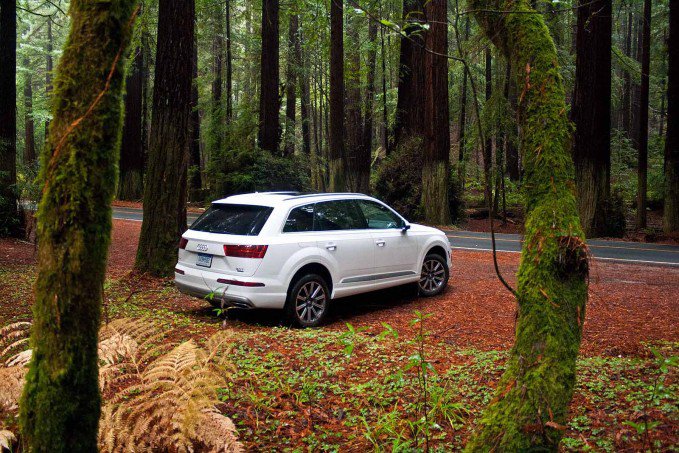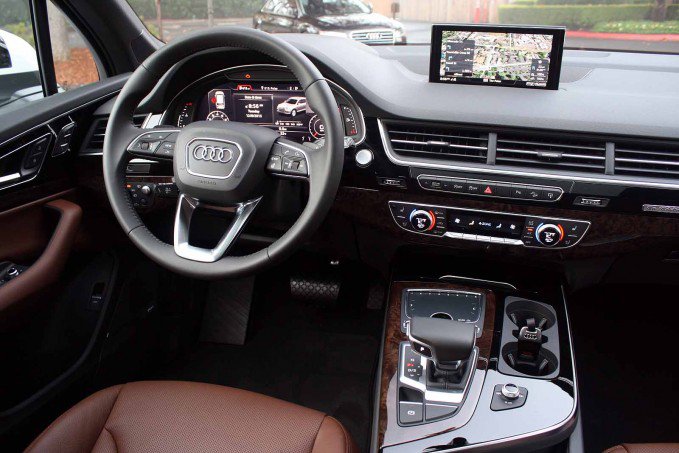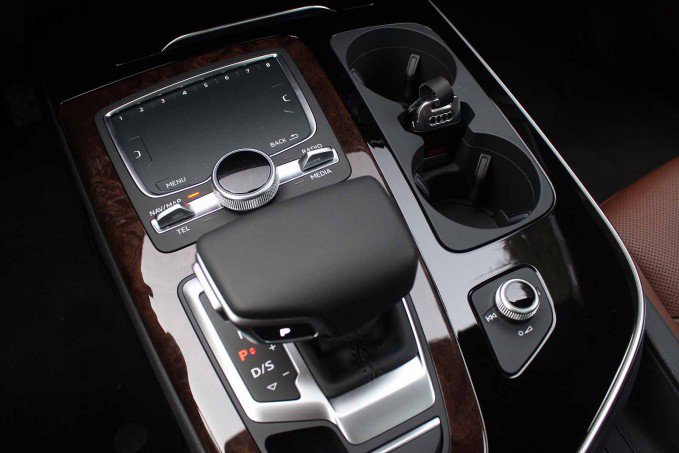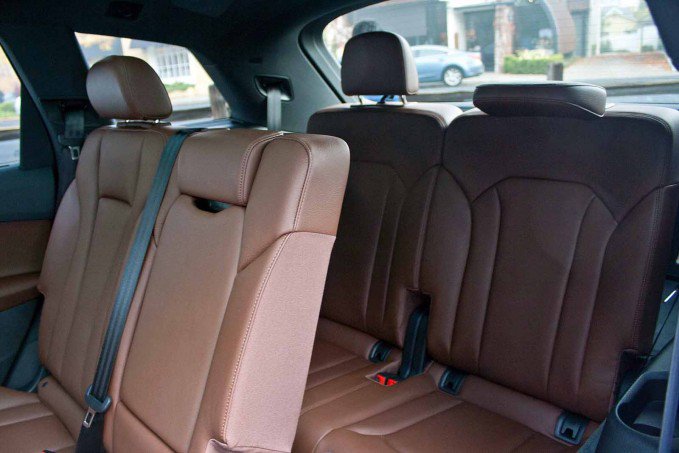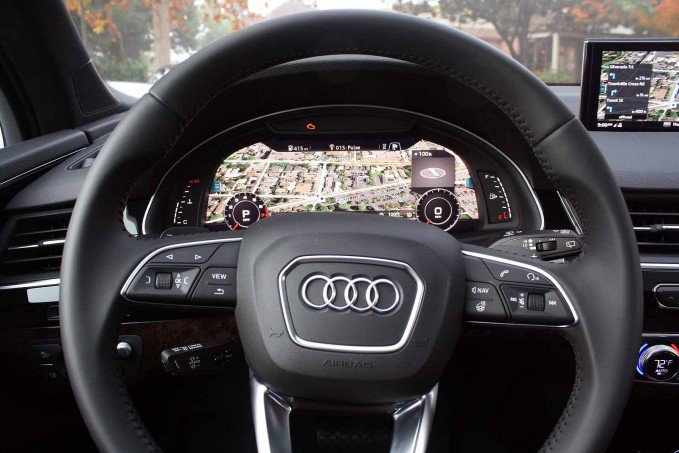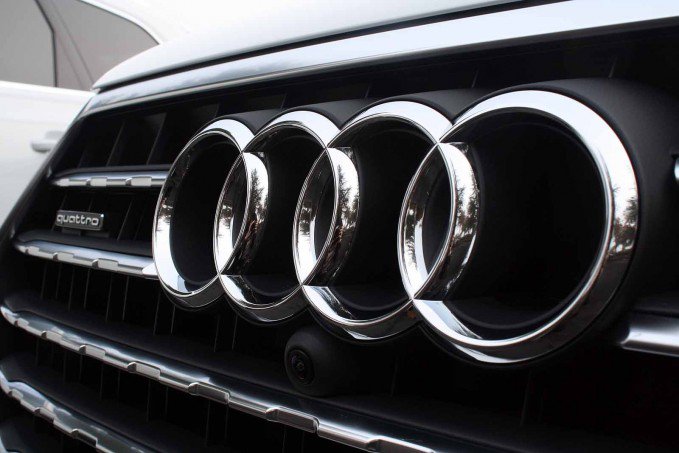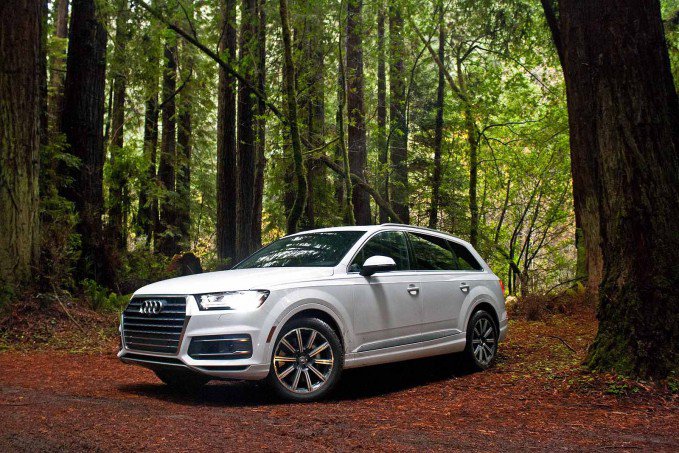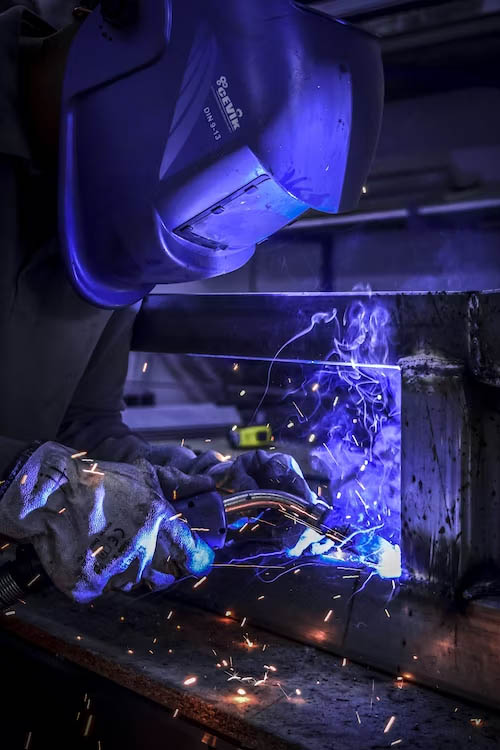Weight has become an evil word in the auto industry recently, and shedding pounds has been the priority for automakers. Audi is no different.
We’re not even talking about sports cars here. Even in big, three-row flagship SUVs like the 2017 Audi Q7 in question, cutting excess weight is happening across the German automaker’s lineup as if Jenny Craig was having a Black Friday sale.
Less Weight, Better SUV
The biggest news with this new Q7 is that it weighs 474 pounds less than the outgoing model, which is like taking a baby grand piano out of the trunk. You can imagine how much that would help driving dynamics and fuel economy. This Q7 uses more aluminum to cut down on weight, which allows the Q7 to be more nimble and to have 17 percent better fuel economy. Official EPA ratings have not yet been released, but Audi says the Q7 should return 19 mpg city, 25 highway and 21 combined. I averaged 21.2 mpg on a mixed and enthusiastic drive route.
Audi has been criticized for having its new cars look exactly like its old ones, but when you compare the old Q7 side by side to the new one, you can see how much tubbier it used to be. The previous-generation model looks portly and slow standing next to its leaner and sharper replacement. There is almost no excess in this car’s exterior, and although it’s not a huge design departure, you can really see the increased focus on streamlining.
German designers will bore you to death with talk of surface tension, precision engineering, dynamism and throw a bunch of math equations at you to try to explain their reasoning, but all you need to know is that this design works. The design is clean, gives the car a stronger stance, and makes it look more like a wagon.
The outside dimensions haven’t changed much, but the Q7 has a lower center of gravity and more interior space.
How Does it Drive?
The new Q7 looks faster, and it has the powertrain to back it up. Powered by a supercharged 3.0-liter V6, it puts out 333 horsepower and 325 pound-feet of torque to all four wheels. Under normal driving conditions, the power is split 40/60 front to back, but up to 85 percent of the power can be sent to the rear wheels when necessary.
ALSO SEE: 2017 Audi A4 Review
Audi claims the Q7 can go from zero to 60 mph in 5.7 seconds, which is 1.2 seconds faster than the previous model — the Q7 has more speed and power than you will ever need. Acceleration is strong and the engine pulls hard across the rev range, but it doesn’t feel as immediately fast as the Volvo XC90, which has a turbocharged and supercharged 2.0-liter four-cylinder and just feels lighter in a straight line. It has less horsepower and torque, but it also weighs 4,394 pounds, 544 less than the Q7. Those pounds make a big difference in how fleet the SUVs are. The Q7 also has a quiet ride, but not as quiet as the XC90, which is more serene.
The Q7 does, however, feel flatter and more stable in corners than its Swedish competition and its new lighter weight means it is definitely more nimble than it used to be. But this is still a 4,938-pound car and you will feel all of those pounds on a twisty road. The Q7’s Dynamic mode tightens things up considerably, and in all modes, the steering has a heavy weight to it and is very precise – it has a great on-center feel and is very responsive to input. The eight-speed Tiptronic shifts quickly and will stay out of your way. Driven around the winding coastal roads of northern California and around the gorgeous Napa county, the surefooted Q7 feels in its natural element.
ALSO SEE: 2016 Volvo XC90 Review
Q7s get optional four-wheel steering, which Audi says gives the SUV more high-speed stability and precision and more low-speed maneuverability. The system can turn the rear wheels up to 5 degrees. In practice, I can’t really feel the difference between models equipped with four-wheel steering, and unless you’re a pro race car driver, I’m not convinced this option is worth it for the average driver. With or without the four-wheel steering, the car is easy enough to maneuver in small spaces.
An adjustable air suspension is also optional. It feels more comfortable than the steel suspension, with the steel setup geared more toward performance and giving more feedback. The air suspension allows up to 90 mm of height adjustability from the tallest to the lowest setting.
In general, the Q7 drives much sportier than a typical three-row SUV, but it is also too heavy to drive like the sport sedan Audi wants it to feel like. Still, for a three-row SUV, it has a perfect balance of sport and comfort.
Sophistication is its Middle Name
Of course, being an Audi, the interior is comfortable and beautiful, the materials used are top shelf, and fit and finish are perfect. In general, the number of buttons has been reduced for a more streamlined look, and the horizontally configured dash sits nice and low, making forward visibility much better.
And yet it still lacks the simple elegance of the XC90’s cabin — the Q7’s interior looks great, but it doesn’t stand out. Part of the reason for this is not offering a touchscreen. Audi’s MMI infotainment system has always been a bit finicky to use, and this version has made it easier and more user friendly, but it could still be better. You can control the system with a giant touchpad where you can input letters by drawing them in with your finger and understands gestures like pinching and swiping, and a rotary knob that also operates like a clickable joystick. The menus themselves have been streamlined and have a flatter structure so there is less hunting around menus to find what you’re looking for.
More storage cubbies would be helpful up front, as there aren’t a lot of places to put things like phones and keys except the cupholders. The center console is also laughably small and shallow, but thankfully, Audi has finally included USB ports, so the car is now Apple CarPlay and Android Auto compatible. There’s also a new smartphone app that is smart watch compatible that can give a user remote access to the car and real time status updates. The available Google maps integration is also brilliant, and allows you to see a satellite image of where you’re going.
Family Oriented
Being a family-oriented SUV, a third row and 5 LATCH positions are standard on all Q7s. The 50/50 third row can be electronically folded flat with buttons that can be accessed in the trunk or by the passenger doors. The third row is a bit cramped and best reserved for kids, but it can hold adults for a quick drive around the corner.
The second row has three seats and splits 35/30/35. Unfortunately, access to the third row isn’t seamless and tumbling the second row is a cumbersome task. The second row should really be power folding or at least a one-step and one-hand operation. Instead, it is a two-step process that requires two hands and a fair amount of upper body strength. This isn’t a huge issue, though, because the third row will usually be stowed away and not in use.
All the Best Features are Options
The Audi Q7 has a bunch of standout features, but most of them don’t come standard. Want a rich 3D sound experience that’s the best audio I’ve ever heard in a car? Prepare to drop about $5,000 on a special Bang & Olufsen system. Does it sound amazing? Yes. Is it worth that money? Probably not.
Even the slick virtual cockpit display with Google Maps integration or head-up display isn’t standard. I wish Audi would just offer some of the best standout features as standard equipment.
Impressive Safety Tech
Audi’s PreSense city safety feature does come standard, however, and will warn you if it detects pedestrians and cars in the vehicle’s path. It can bring the car to complete halt to avoid a collision.
Instead of just taking their word for it, Audi made a leap of faith and demonstrated their safety features first hand. This shows tremendous confidence in their technology.
The adaptive cruse control (ACC) works seamlessly (although it could be easier to set up), and the traffic jam assistant makes the gruelling task of sitting through a traffic jam less stressful by keepi
ng a safe distance between you and the car in front. It can slow down, speed up, stop and get going again all on its own. Another interesting feature is that the car uses GPS to monitor speed limits and will adjust the car’s speed accordingly if the ACC is activated.
Cross traffic assist proved very useful and warns you if there are cars approaching if you’re backing out of a parking spot. The system sends off an audio warning first and then if the driver doesn’t respond, the car will come to a complete halt on its own to avoid a crash. The cross traffic alert package also comes with an exit assist feature that gives you a visual warning if there is a bike or car coming as you’re opening the door.
Lane keep assist, traffic sign recognition, large animal detection, high-beam assistant, turn assist, and a top-view camera are all optional.
A self-parking assist is suspiciously absent. All the radar, cameras and sensors are already there, so it would be a bonus if the Q7 could park itself. When asked why this was excluded, Audi executives told me that other systems don’t work 100 percent of the time and Audi isn’t comfortable having this feature available until it is completely fail proof.
The Diesel Question
As of right now, the 3.0-liter V6 is the only engine available. A diesel and a diesel plug-in hybrid were supposed to make their way over, but their status is now up in the air. Audi executives told me they are “still working hard to resolve this.” The diesel plug-in hybrid would have been a gamechanger, and this is the powertrain I’m most excited for.
The Verdict: 2017 Audi Q7 Review
The Q7 isn’t a gamechanger like the Volvo XC90 was, and it’s not as sporty as Audi wants you to believe, but the SUV is still a solid performer. It feels great to drive and luxury oozes out from every pore. The amount of available technology in the Q7 is staggering and, as always, the build quality is some of the industry’s best. One of the Audi’s best qualities is also how infinitely adjustable is it to suit your personal tastes and needs.
Discuss this story on our Audi Forum



